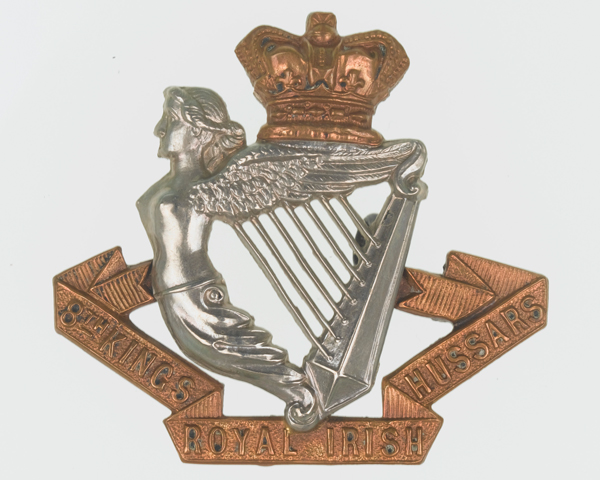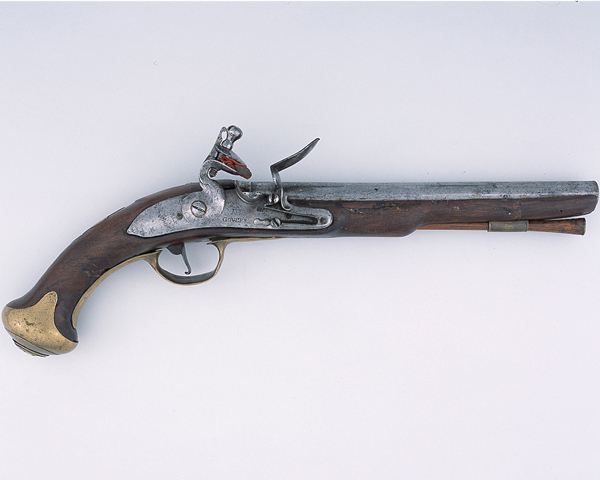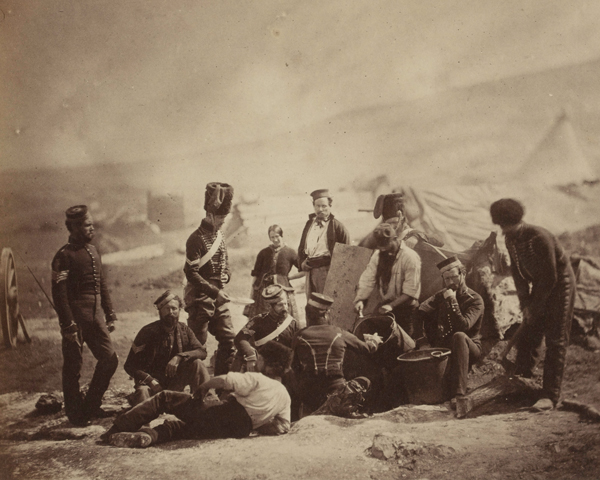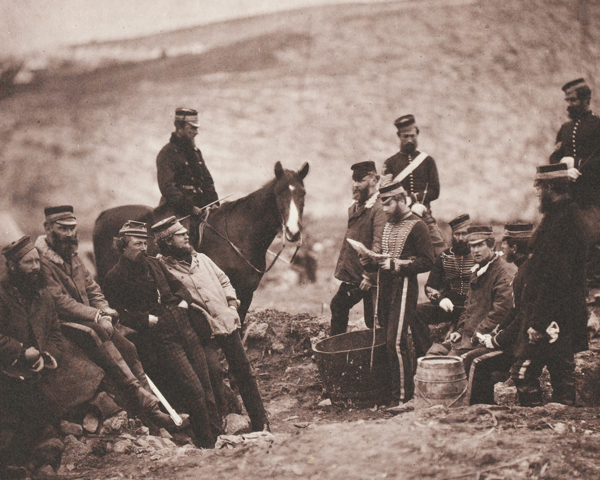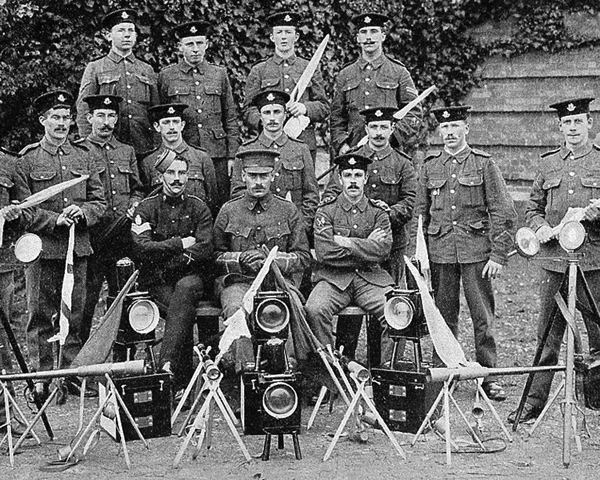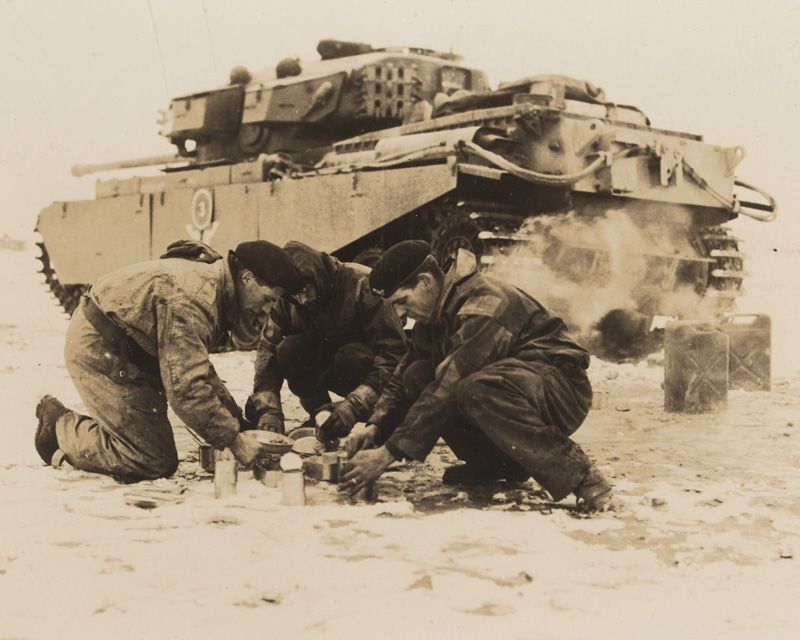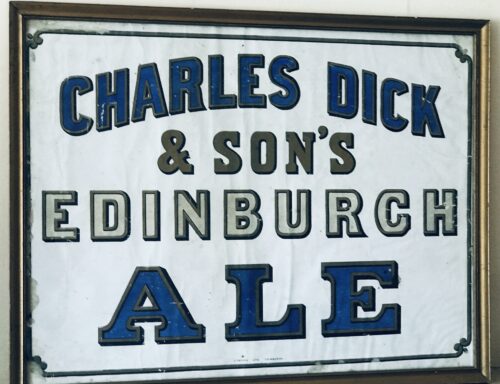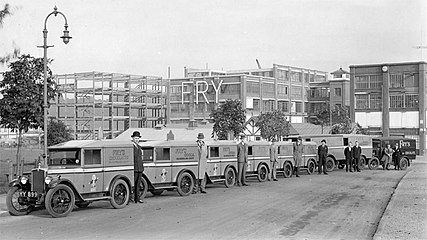| Desert Orchid | |
|---|---|
 |
|
| Sire | Grey Mirage |
| Grandsire | Double-U-Jay |
| Dam | Flower Child |
| Damsire | Brother |
| Sex | Gelding |
| Foaled | 11 April 1979 in Goadby, Leicestershire, England. |
| Country | Great Britain |
| Colour | Grey |
| Breeder | James Burridge |
| Owner | James Burridge, Midge Burridge, Richard Burridge, Simon Bullimore |
| Trainer | David Elsworth at Whitsbury Manor Racing Stables, Fordingbridge, Wiltshire |
| Record | 70: 34-11-8 |
| Earnings | £654,066 |
| Major wins | |
| Tolworth Hurdle (1984) Kingwell Hurdle (1984) Hurst Park Novices' Chase (1985) King George VI Chase (1986, 1988, 1989, 1990) Gainsborough Chase (1987, 1989, 1991) Martell Cup (1988) Whitbread Gold Cup (1988) Tingle Creek Chase (1988) Victor Chandler Chase (1989) Cheltenham Gold Cup (1989) Racing Post Chase (1990) Irish Grand National (1990) | |
| Awards | |
| Timeform rating: 187 | |
| Honours | |
| The Desert Orchid Chase at Wincanton Desert Orchid Chase at Kempton Park Racecourse Statue, ashes, headstone - Kempton Park Racecourse | |
-

 Although Dessie had no Irish connection whatsoever ,we love a good horse in Ireland and by God Desert Orchid was some horse.Its said his appearance in Fairhouse when he own the Irish Grand National was akin to JFK or the Pope arriving ! Trim Co Meath. 62cm x 50cm
Although Dessie had no Irish connection whatsoever ,we love a good horse in Ireland and by God Desert Orchid was some horse.Its said his appearance in Fairhouse when he own the Irish Grand National was akin to JFK or the Pope arriving ! Trim Co Meath. 62cm x 50cm
Desert Orchid (11 April 1979 – 13 November 2006), known as Dessie, was an English racehorse. The grey achieved a revered and esteemed status within National Hunt racing, where he was much loved by supporters for his front-running attacking style, iron will and extreme versatility. He was rated the fifth best National Hunt horse of all time by Timeform. During his racing career he was partnered by five different jump jockeys: Colin Brown, Richard Linley, Simon Sherwood, Graham Bradley and Richard Dunwoody. -

 55cm x 45cm Doneraile Co Cork Classic Players Please Navy Cut advertising showcard depicting the great Triple Crown Winner Ormonde. Ormonde (1883–1904) was an English Thoroughbred racehorse who won the English Triple Crown in 1886 and retired undefeated. He also won the St. James's Palace Stakes, Champion Stakes and the Hardwicke Stakes twice. At the time he was often labelled as the 'horse of the century'. Ormonde was trained at Kingsclere by John Porter for the 1st Duke of Westminster. His regular jockeys were Fred Archer and Tom Cannon. After retiring from racing he suffered fertility problems, but still sired Orme, who won the Eclipse Stakes twice.
55cm x 45cm Doneraile Co Cork Classic Players Please Navy Cut advertising showcard depicting the great Triple Crown Winner Ormonde. Ormonde (1883–1904) was an English Thoroughbred racehorse who won the English Triple Crown in 1886 and retired undefeated. He also won the St. James's Palace Stakes, Champion Stakes and the Hardwicke Stakes twice. At the time he was often labelled as the 'horse of the century'. Ormonde was trained at Kingsclere by John Porter for the 1st Duke of Westminster. His regular jockeys were Fred Archer and Tom Cannon. After retiring from racing he suffered fertility problems, but still sired Orme, who won the Eclipse Stakes twice.Background
Ormonde was a bay colt, bred by Hugh Grosvenor, 1st Duke of Westminster and foaled in 1883 at Eaton Stud in Cheshire. Ormonde's sire was The Derby and Champion Stakes winner Bend Or, also bred by the Duke. Bend Or was a successful stallion, his progeny included Kendal, Ossory, Orbit, Orion, Orvieto, Bona Vista and Laveno. Ormonde's dam was Doncaster Cup winner Lily Agnes. She was sired by another Derby winner, Macaroni. Lily Agnes began to experience problems with her lungs as a four-year-old, to the extent that jockey John Osborne said he could hear her approaching before he saw her. The problem did not interfere with her racing ability as she continued to win at four and five. She then became a top broodmare also foaling 1000 Guineas winner Farewell, Ormonde's full-brother Ossory and another full-brother Ornament, who produced the outstanding Sceptre, the only racehorse to win four British Classic Races outright. Ormonde was born at half-past six in the evening of 18 March 1883. The Duke's stud-groom Richard Chapman stated that for several months after foaling, Ormonde was over at the knee. Chapman later said he had never before or since seen a horse with the characteristic so pronounced and that it had seemed impossible for him to ever grow straight. Ormonde did gradually grow out of the problem though and by the time he left the stud to go into training at Kingsclere, trainer John Porter told the Duke he was the best yearling the Duke had sent him. However during the winter of 1884/85, Ormonde had trouble with his knees. The treatment he received for this held his training back considerably, with him only having easy cantering exercises until the summer of 1885. Ormonde grew into a well-built horse standing 16 hands (64 inches, 163 cm) with excellent bone and straight hocks. Porter later said his neck "was the most muscular I ever saw a Thoroughbred possess." He had an excellent shoulder and short powerful hindquarters that led some to call him a racing machine. When galloping, he held his head low and had a notably long stride. He had a kind temperament, healthy appetite and strong constitution. Porter stated the horse was fond of flowers and would even eat the boutonniere from the jacket of anyone within reach.Racing career
1885: Two-year-old season
Prior to his racecourse debut, Porter ran Ormonde in a trial against Kendal, Whipper-in and Whitefriar. Kendal, carrying one pound less, won the trial by a length from Ormonde. Kendal had already had a number of races by this point and Ormonde was nowhere near fully fit. By this point he stood 16 hands high and had a very muscular neck and strong back. Porter also noted that when extended, Ormonde had a very long stride. The Duke rode him in a couple of canters and remarked "I felt every moment that I was going to be shot over his head, his propelling power is so terrific." As a two-year-old, Ormonde did not race until October when he won the Post Sweepstakes race at Newmarket. He started at 5/4 with the filly Modwena, who had won eight races out of ten that year, the 5/6 favourite. In the heavy going, Ormonde went on to win by a length from Modwena. Ormonde's next racecourse appearance came in the Criterion Stakes, again at Newmarket, where his opposition included Oberon and Mephisto. Starting at 4/6, Ormonde won easily by three lengths from Oberon, with Mephisto a distant third. He then started the Dewhurst Plate as the 4/11 favourite, ridden by Fred Archer. After an even start, Ormonde was positioned just behind the leader. As they neared the closing stages, Archer let Ormonde go and he quickly pulled away from the field to beat his stablemate, Whitefriar, easily by four lengths.The field also included Miss Jummy, who went on to win the 1000 Guineas and Epsom Oaks. These three victories earned him £3008. 1885 was considered to have had the best group of two-year-olds for many years.1886: Three-year-old season
Going into the 1886 season, Ormonde was one of the favourites for the Derby. He was priced at 11/2, similar to Minting, Saraband and The Bard.2000 Guineas
Ormonde started off his three-year-old campaign in the 2000 Guineas at Newmarket. The race was considered a clash between Ormonde, the unbeaten Middle Park winner Minting and Saraband. In a small field of six, Minting was sent off the 11/10 favourite, Saraband at 3/1 and Ormonde at 7/2. This time Ormonde was ridden by George Barrett, with Fred Archer riding Saraband. The horses ran almost in line in the early stages. Saraband began to struggle and was beaten with two furlongs to run. At this point Ormonde and Minting took over the lead from St. Mirin. Ormonde then went on to record as easy 2 length victory over Minting, with Mephisto a further 10 lengths back in third, who in turn was two lengths ahead of Saraband.Engraving of the closing stages of the 1886 Derby, with Ormonde leading The BardThe Derby
After his Newmarket performance, Ormonde was the favourite for the Derby with Fred Archer back as his jockey. A small field of 9 went to post, with Ormonde the 40/85 favourite and his main opposition, The Bard, at 7/2 who. The Bard was also undefeated and had won many races as a two-year-old. The start was not even, with outsider Coracle almost 6 lengths clear of Ormonde, who was a similar distance clear of the rest. Ormonde and The Bard took over the lead at Tattenham corner and the two raced up the straight. The Bard got a neck in front, but when Archer asked Ormonde for an effort, he pulled in front to win by 1½ lengths from The Bard, with St. Mirin a further 10 lengths back in third.Royal Ascot
At Royal Ascot against just two opponents, Ormonde lined up as the 3/100 favourite for the St. James's Palace Stakes. He won easily by ¾ length from Calais. Three days later he faced a stronger field in the Hardwicke Stakes including 1885 Derby and St Leger winner Melton. Ormonde, the 30/100 favourite, won easily again though, beating Melton by 2 lengths. He then had a break from the racecourse. After Ascot Ormonde was already as short as 1/2 for the St Leger.Autumn
While Ormonde was galloping one morning shortly before the St Leger Stakes, Porter noticed him making a whistling noise.In spite of this infirmity, Ormonde started the final classic of the year as the 1/7 favourite. Ridden again by Archer, he pulled away half a mile out and won easily by 4 lengths from St. Mirin, without even being asked for an effort. The win made him the fourth winner of the English Triple Crown. He next ran in the Great Foal Stakes at Newmarket, again winning easily by three lengths from Mephisto.[13] He then won the Newmarket St Leger in a walkover and the Champion Stakes as the 1/100 favourite by a length from Oberon. Ormonde then entered a free handicap at Newmarket. Starting the 1/7 favourite and carrying 9 st 2 lb, he won by eight lengths from Mephisto, to whom he was conceding 28 lbs. At the same meeting he won a private sweepstakes in a walkover. The sweepstakes was an originally scheduled as a match race between Ormonde, The Bard, Melton and possibly Bendigo, the 1886 Eclipse winner. Bendigo was not nominated from the race in the end. The Bard and Melton were though and both forfeited £500 to Ormonde's connections. Throughout the end of the season, Ormonde's breathing had become progressively louder until he was labelled a roarer.1887: Four-year-old season
Ormonde did not race until June 1887. His return was assisted by an experimental treatment involving "galvanic shocks" being applied daily to his chest and throat.His reappearance came at Royal Ascot in the Rous Memorial Stakes, where his opposition included Kilwarlin, who went on to win the season's St. Leger Stakes. Ormonde was conceding 25 pounds to Kilwarin and before the race Kilwarin's owner Captain Machell said to Porter, "The horse was never foaled that could give Kilwarin 25 pounds and beat him." After Fred Archer's suicide, Tom Cannon was now Ormonde's jockey. He led the race throughout and won easily by six lengths from Kilwarlin, with Agave a distant third. Upon seeing Captain Machell in the paddock after the race Porter said, "Well, what did you think of it now?" Machell replied, "Ormonde is not a horse at all; he's a damned steam-engine." He raced again the next day in the Hardwicke Stakes, where he faced a strong field including Minting and Eclipse Stakes winner Bendigo. Minting's trainer Matt Dawson was confident that his horse could win this time due to Ormonde's breathing problems. As the four runners made their way to the starting post he remarked to Porter "You will be beaten today, John. No horse afflicted with Ormonde's infirmity can hope to beat Minting."Indeed, Porter himself admitted he was not overly confident of victory. During the race George Barrett, aboard Phil, impeded Ormonde and he was made to struggle for the first time in his career. During the closing stages, Ormonde and Minting battled with each other and Ormonde just came out on top, winning by a neck, with Bendigo in third. In his final race, he won the 6 furlong Imperial Gold Cup at Newmarket. Starting at 30/100 he made all the running and won by two lengths from Whitefriar. Ormonde was then retired as the most celebrated horse of his era. He was sent by train to Waterloo Station, then walked to Grosvenor House in Mayfair, where he was the guest of honor at a garden party to celebrate Queen Victoria's Golden Jubilee.Race record
Date Race name D(f) Course Prize (£) Odds Runners Place Margin Runner-up Time Jockey 14 October 1885 Post Sweepstakes 6 Newmarket 500 5/4 3 1 1 Modwena Fred Archer 26 October 1885 Criterion Stakes 6 Newmarket 906 4/6 6 1 3 Oberon Fred Archer 28 October 1885 Dewhurst Stakes 7 Newmarket 1602 4/11 11 1 4 Whitefriar Fred Archer 28 April 1886 2000 Guineas 8 Newmarket 4000 7/2 6 1 2 Minting 1:46.8 George Barrett 26 May 1886 Epsom Derby 12 Epsom Downs 4700 40/85 9 1 1.5 The Bard 2:45.6 Fred Archer 10 June 1886 St. James's Palace Stakes 8 Ascot 1500 3/100 3 1 0.75 Calais Fred Archer 13 June 1886 Hardwicke Stakes 12 Ascot 2438 30/100 5 1 2 Melton 2:43 George Barrett 15 September 1886 St Leger Stakes 14.5 Doncaster 4475 1/7 7 1 4 St Mirin 3:21.4 Fred Archer 29 September 1886 Great Foal Stakes 10 Newmarket 1140 1/25 3 1 3 Mephisto Fred Archer 1 October 1886 Newmarket St Leger 16 Newmarket 475 N/A 1 1 Walkover Walkover Fred Archer 15 October 1886 Champion Stakes 10 Newmarket 1212 1/100 3 1 1 Oberon 2:19 Fred Archer 28 October 1886 Free Handicap 10 Newmarket 650 1/7 3 1 8 Mephisto 2:22 Fred Archer 29 October 1886 Private Sweepstakes 10 Newmarket 1000 N/A 1 1 Walkover Walkover Fred Archer 9 June 1887 Rous Memorial Stakes 8 Ascot 920 1/4 1 6 Kilwarlin Tom Cannon 12 June 1887 Hardwicke Stakes 12 Ascot 2387 4/5 4 1 0.25 Minting 2:44.4 Tom Cannon 16 July 1887 Imperial Gold Cup 6 Newmarket 590 30/100 3 1 2 Whitefriar 1:18 Tom Cannon Assessment
Ormonde is generally considered one of the greatest racehorses ever. At the time he was often labelled as the 'horse of the century'. His achievements are even more impressive considering the strength of some of the other horses foaled in 1883. It is said that both Minting and The Bard were good enough to have won The Derby nine out of ten years. In early 1888 Minting, the horse Ormonde beat easily in the 2000 Guineas, was rated 15 pounds superior to the 1887 Derby winner Merry Hampton and the 1887 St Leger winner Kilwarlin.Stud record
Ormonde went to the Duke of Westminster's Eaton Stud in 1888, where he sired seven foals from the sixteen mares he covered, including Goldfinch and Orme. In 1889, he was moved to Moulton Paddocks in Newmarket, but became sick and could only cover a few mares, with only one live foal produced in 1890. He was subsequently returned to Eaton Stud but his fertility never recovered. To the astonishment of many, Ormonde was then sold overseas. Both he and his dam were roarers, and the Duke felt this could weaken English bloodstock. Ormonde was sold to Senor Bocau of Argentina for £12,000, and then in 1893 to William O'Brien Macdonough, of California for £31,250. He stood at the Menlo Stock Farm in California for several years, where he sired 16 foals. including Futurity Stakes winner Ormondale.English foals
c = colt, f = filly
Despite only siring eight horses in England, Ormonde had a signficant impact at stud. Orme was the leading sire in Great Britain and Ireland when he sired another Triple Crown winner, Flying Fox, who went on to be a leading sire in France. Orme also sired Epsom Derby winner Orby and 1000 Guineas winner Witch Elm. Goldfinch sired 1000 Guineas winner Chelandry. After being sold and moving to California, Goldfinch sired Preakness Stakes winner Old England. In America, his son Ormondale went on to sire Jockey Club Gold Cup winner Purchase. Ormonde died in 1904 at age 21 at Rancho Wikiup in Santa Rosa, California. His disarticulated skeleton/skull were later returned to the Natural History Museum in South Kensington, London.His male line survives mainly through Teddy, grandson of Flying Fox. Orby does still have a sire line as well. Ormonde may have been the model for the fictional horse Silver Blaze in Arthur Conan Doyle's Sherlock Holmes short story "The Adventure of Silver Blaze" (1892).Foaled Name Sex Notable wins Wins Prize money 1889 Goldfinch c Biennial Stakes, New Stakes 2 £2,464 1889 Kilkenny f 1 £164 1889 Llanthony c Ascot Derby 4 £3,139 1889 Orme c Middle Park Plate, Dewhurst Plate, Eclipse Stakes (twice), Sussex Stakes, Champion Stakes, Limekiln Stakes, Rous Memorial Stakes, Gordon Stakes 14 £32,528 1889 Orontes II f 0 1889 Orville c 0 1889 Sorcerer c 1 £229 1890 Glenwood c Aylesford Foal Plate 2 £1,726 -

 St Marys Cathedral from Ferrars History of Limerick, first published in 1787.There are very few copies still in existence and these 5 prints were generously taken from 16 original engravings in the first edition 35cm x 40cm Limerick Limerick Cathedral (Saint Mary's) is dedicated to the Blessed Virgin Mary and was founded in 1168 and is the oldest building in Limerick which is in use. It has the only complete set of misericords left in Ireland. In 1111, the Synod of Ráth Breasail decided that "Saint Mary's church" would become the cathedral church of the Diocese of Limerick. According to tradition, Domnall Mór Ua Briain, the last King of Munster, founded the present cathedral on the site of his palace on King's Island in 1168.[3] The palace had been built on the site of the Viking meeting place, or "Thingmote" – the Vikings' most westerly European stronghold.[1] This had been the centre of government in the early medieval Viking city. Parts of the palace may be incorporated into the present structure of the cathedral, most prominently the great west door, which is claimed to have been the original main entrance to the royal palace.The west door is now only used on ceremonial occasions. The bishops of Limerick have for centuries knocked on this door and entered by it as part of their installation ceremony. According to tradition, during the many sieges of Limerick the defenders of the city used the stones around the west door to sharpen their swords and arrows, and the marks they made in the stonework can be seen there today. The tower of Saint Mary's Cathedral was added in the 14th century. It rises to 120 feet (36.58 meters), containing a peal of 8 bells, of which 6 were cast by John Taylor & Co, Loughborough, and 2 cast in Whitechapel, London. The tower also contains a stationary service bell, which can be rung from the ground floor.
St Marys Cathedral from Ferrars History of Limerick, first published in 1787.There are very few copies still in existence and these 5 prints were generously taken from 16 original engravings in the first edition 35cm x 40cm Limerick Limerick Cathedral (Saint Mary's) is dedicated to the Blessed Virgin Mary and was founded in 1168 and is the oldest building in Limerick which is in use. It has the only complete set of misericords left in Ireland. In 1111, the Synod of Ráth Breasail decided that "Saint Mary's church" would become the cathedral church of the Diocese of Limerick. According to tradition, Domnall Mór Ua Briain, the last King of Munster, founded the present cathedral on the site of his palace on King's Island in 1168.[3] The palace had been built on the site of the Viking meeting place, or "Thingmote" – the Vikings' most westerly European stronghold.[1] This had been the centre of government in the early medieval Viking city. Parts of the palace may be incorporated into the present structure of the cathedral, most prominently the great west door, which is claimed to have been the original main entrance to the royal palace.The west door is now only used on ceremonial occasions. The bishops of Limerick have for centuries knocked on this door and entered by it as part of their installation ceremony. According to tradition, during the many sieges of Limerick the defenders of the city used the stones around the west door to sharpen their swords and arrows, and the marks they made in the stonework can be seen there today. The tower of Saint Mary's Cathedral was added in the 14th century. It rises to 120 feet (36.58 meters), containing a peal of 8 bells, of which 6 were cast by John Taylor & Co, Loughborough, and 2 cast in Whitechapel, London. The tower also contains a stationary service bell, which can be rung from the ground floor.Notable burials
-
Bishop Charles Graves The cathedral graveyard contains many graves and tombs of notable people. The physician Samuel Crumpe is buried in the graveyard near the great west door. Prince Milo of Montenegro, Frances Condell (first woman Mayor of Limerick) and Bishop Charles Graves are also interred in the grounds. The last High King of Munster, Domnall was purportedly buried in the cathedral, with the remnants of his stone coffin still visible in the Cathedral chancel. Bishop Cornelius O'Dea is buried alongside several other Bishops of Limerick in what is believed to be an Episcopal vault underneath the chancel itself. Also notable are the Sexton, Barrington, Boyd and Vanderkiste tombs along the south entrance pathway.
From the Irish Reformation to the 19th century
There are five chandeliers which hang from the ceiling. These are only lit on special occasions. The larger three of the five were made in Dublin and presented in 1759 by the Limerick Corporation. The belfry holds a peal of eight bells, six of which were presented by William Yorke, mayor of Limerick, in 1673. An active team of bell ringers travels the country to compete with other campanologists.Saint Mary's received its organ in 1624, when Bishop Bernard Adams donated one. It has been rebuilt over the centuries and was most recently renovated in 1968 and 2005. In 1620 the English-born judge Luke Gernon, a resident of Limerick, wrote a flattering description of the cathedral: "not large, but lightsome, and by the providence of the Bishop fairly beautified within, and as gloriously served with singing and organs". During the Irish Confederacy wars, the cathedral was briefly transferred to Roman Catholic hands. The bishop of Limerick, Richard Arthur, was buried in the cathedral in 1646. In 1651, after Oliver Cromwell's forces captured Limerick, the cathedral was used as a stable by the parliamentary army. This misuse was short lived, but was a similar fate to that suffered by some of the other great cathedrals during the Cromwellian campaign in Ireland. The troops also removed the cathedral's original 13 ft Pre-Reformation high altar from the cathedral. The altar was only reinstated in the 1960s. It is the largest such altar in Ireland and the UK, carved from a single limestone block. The altar is used for communion services at major festivals and remains in its historic location in what is now the chapel of the Virgin Mary or Lady Chapel. In 1691, the cathedral suffered considerable damage, particularly on the east end, during the Williamite Siege of Limerick.After the Treaty of Limerick, William granted £1,000 towards repairs. There are cannonball from 1691 in the Glentworth Chapel/Saint George's Chapel inside.From the 19th century to the 20th century
In 1968, the Irish Government commissioned two postage stamps to commemorate the cathedral's 800 year anniversary. A picture of one of the stamps is displayed on this page. In 1991, there was a large £2.5 million restoration programme which was completed in 1996 with the excavation and re-laying of the floors as well as the installation of underfloor central heating. Restoration continues today to a lesser degree.From the 20th century to the 21st century
Today the cathedral is still used for its original purpose as a place of worship and prayer for everybody. It is also the 3rd biggest tourist attraction in Limerick. It is open to the public every day from 9:00 am to 4:45 pm. For Tourists there is a €5 admission charge upon entry. This money is essential for the upkeep of the building, and without it, the cathedral simply could not function. Following the retirement of the Very Rev'd Maurice Sirr on 24 June 2012, Bishop Trevor Williams announced the appointment of the Reverend Sandra Ann Pragnell as Dean of Limerick and Rector of Limerick City Parish. She was the first female dean of the cathedral and rector of Limerick City Parish, and retired in January 2017. It was announced on 27 August 2017, that the Reverend Canon Niall James Sloane was to become the 63rd Dean of Limerick and the new rector of Limerick City Parish; with his installation and institution taking place on 21 October 2017 in the cathedral. The cathedral grounds holds United Nations Memorial Plaque with the names of all the Irish men who died while serving in the United Nations Peacekeepers.The History of Limerick by James Ferrar published in 1787 is a history of Limerick city from ancient times until the late 18th century. Limerick was an important medieval stronghold, became an important port and trading centre, was subject to a series of sieges in the 17th century and finally experienced a brief golden age of prosperity during the Georgian period of the late 18th century. Limerick or Luimneach was an ancient settlement long before the Vikings captured it and established their own town there in the 9th century. They used it as a base for trade and also to launch raids up the River Shannon against monastic sites like Clonmacnoise and other wealthy Christian centres. However in the 11th century the last Viking king of Limerick was defeated by King Brian Boru. In 1174, the Norman conquerors who had already seized Dublin , Leinster and Munster captured the city of Limerick . It was given its city charter by King Richard I in 1197 and a castle fortress was built by King John about 1200. The medieval city featured a walled town known as Englishtown on the north side of the River Shannon. Irishtown was inhabited by the Irish and Vikings was on the south side of the river. Both were eventually walled and linked by bridges over the Shannon . Limerick would retain formidable defenses until the 17th century when it experienced four separate sieges during the period of the English Civil War and the Williamite Wars. Catholic rebels forced the English garrison to surrender in 1642 and a Parliamentarian Army in turn forced a Catholic and Royalist garrison to surrender in 1651. It was twice besieged in 1690 and 1691 by the forces of William III of Orange who forced Jacobins fighting on the sides of the Catholic James II to surrender and go into exile. From the late 17th to the 19th centuries an Anglo-Irish Protestant elite controlled Ireland . In Limerick in the late 1700s Limerick merchants prospered and Edmund Pery, 1st Viscount Pery had much of the south side of the city redesigned with a grid of Georgian brick terraces and neo-classical stone buildings. The Georgian area still survives in the 21st century and Prey Square is named in Edmund Prey's honour. Unfortunately the Irish economy declined in the early 19th century as the Irish Parliament was switched from College Green, Dublin to the House of Commons in London and Ireland remained a near feudal agricultural society as Britain rapidly industrialised. Like Dublin , Limerick 's best days were behind it as slums flourished and in the 1840s the city population swelled as the poor fled from the land after the failure of the potato crop. -
-

 Beautiful example of WW1 sweetheart artwork -an embroidered regimental crest for the Royal Irish Kings Hussars 34cm x 34cm Birr Co Offaly
Beautiful example of WW1 sweetheart artwork -an embroidered regimental crest for the Royal Irish Kings Hussars 34cm x 34cm Birr Co OffalyOrigins
Raised as a dragoon unit in 1693, this regiment was originally formed from Protestants living in Ireland. This was only two years after supporters of the deposed King James II had been decisively defeated at the Battle of Aughrim, so the new regiment remained in Ireland on policing duties. In 1704, it was posted to Portugal and Spain during the War of the Spanish Succession (1701-14). It remained there until its capture at Brihuega in 1710. Following a prisoner exchange, the regiment returned to Ireland, where it disbanded in April 1714. However, the First Jacobite Rebellion triggered its re-formation in July 1715. It went on to fight against both Jacobite Rebellions, but otherwise remained in Ireland from 1715 until 1794. The regiment was designated the 8th Regiment of Dragoons in 1751. It became a light dragoon unit in 1775 and gained the ‘King’s’ prefix two years later.Cap badge, other ranks, 8th (King's Royal Irish) Hussars, c1900Flintlock pistol used by Lieutenant-General Richard St George, Colonel of the 8th Dragoons, c1750QuizWhich of the following was a nickname of the 8th Hussars?The cross bowsThe cross swordsThe cross beltsWar with France
In 1794, the regiment was posted to the Low Countries during the French Revolutionary War (1793-1802). From 1796, it garrisoned the Cape of Good Hope before sending a detachment to join General Sir Ralph Abercrombie’s force in Egypt in 1801.India
In 1802, it sailed to India, where it stayed for 22 years, fighting in the Second and Third Maratha Wars (1803-05, 1817-18), as well as campaigning against Meer Khan in 1812 and in Nepal in 1814. In 1822, just after its return to Britain, it was renamed and re-equipped as a hussar regiment, keeping order in England and Ireland for the next 30 years.Crimea
It fought against the Russians at Silistra on the Danube, en route to the main theatre of the Crimean War (1854-56). There, it served at the Alma (1854) and took part in the infamous Charge of the Light Brigade at Balaklava (1854). The charge was led by the Earl of Cardigan, who had been an officer in the 8th Hussars from 1824 to 1830.Cooking house of the 8th (The King's Royal Irish) Light Dragoons (Hussars), c1855Officers and men of the 8th (The King's Royal Irish) Light Dragoons (Hussars), 1855Return to India
Only 154 members of the regiment returned from the Crimea in 1856. They were in Ireland for less than a year before being dispatched to deal with the Indian Mutiny (1857-59). One of the regiment’s squadrons fought at Gwalior, where four of its soldiers won the Victoria Cross and a fifth killed the Rani of Jhansi. It then formed part of India’s garrison until 1864, and again from 1878 to 1889, guarding lines of communication between Kabul and Peshawar during the Second Afghan War (1878-80) and fighting against the Shinwarrie tribe. It spent the rest of the 19th century in England and Ireland. And from there, it sailed to the Boer War (1899-1902) in 1900, taking part in the anti-guerrilla operations.Signallers of the 8th (King's Royal Irish) Hussars, c1908Tanks of the 8th King's Royal Irish Hussars in Hamburg, May 1945World Wars
The regiment spent the First World War (1914-18) on the Western Front, fitting in several engagements including Givenchy (1914) the Second Battle of Ypres (1915) and the Somme(1916). It made its last mounted charge there in 1917. In 1919, it was posted to Iraq and then to Germany in 1926, before moving to Egypt and Palestine from 1933 to 1939. During this period, it was also converted to armoured cars and then light tanks. During the Second World War (1939-45), the regiment saw a lot of action in North Africa(1940-42) and Greece (1941). The former campaign included the Battles of Sidi Barrani, Bardia, Beda Fomm and Sidi Rezegh in 1941, the Gazala battles of May-June 1942 and El Alamein in October 1942. The regiment then returned to Britain to prepare for the invasion of Europe. It landed with its Cromwell tanks two days after D-Day (June 1944), fighting throughout the North West Europecampaign before ending the war near Hamburg. It then joined the occupation forces.A tank crew from the 8th (King’s Royal Irish) Hussars make a meal on the Imjin front, 1951Legacy
The regiment’s final campaign was in Korea between 1950 and 1952, which included service on the Imjin River. It then moved to Germany to join the British Army of the Rhine. Due to heavy losses in 1942, the regiment had temporarily merged with the 4th Queen's Own Hussars. This amalgamation was enacted again in October 1958 - this time permanently - to form The Queen's Own Royal Irish Hussars. -

 Team photograph of the Irish Rugby Team that played Wales in the first ever Rugby International ever held in Limerick in the County Cricket Grounds (now the Limerick Lawn Tennis Club) Ennis Road on the 19th March 1898. 42cm x 30cm Parnell St Limerick City
Team photograph of the Irish Rugby Team that played Wales in the first ever Rugby International ever held in Limerick in the County Cricket Grounds (now the Limerick Lawn Tennis Club) Ennis Road on the 19th March 1898. 42cm x 30cm Parnell St Limerick City
 7Vintage advert for the 4 and 3 Seater Chevrolet (Agent ;The North Tipperary Motor Company P Flannery 6 & 7 McDonagh St Nenagh Co Tipperary).The 4 seater delivered complete cost £210 with the 3 seater English Body costing a heftier £280. 33cm x 44cm Nenagh Co Tipperary In November 3, 1911, Swiss race car driver and automotive engineer Louis Chevrolet co-founded the "Chevrolet Motor Company" in Detroit with William C. Durant and investment partners William Little (maker of the Little automobile), former Buick owner James H. Whiting,[6] Dr. Edwin R. Campbell (son-in-law of Durant) and in 1912 R. S. McLaughlin CEO of General Motors in Canada. Durant was cast out from the management of General Motors in 1910, a company which he had founded in 1908. In 1904 he had taken over the Flint Wagon Works and Buick Motor Company of Flint, Michigan. He also incorporated the Mason and Little companies. As head of Buick, Durant had hired Louis Chevrolet to drive Buicks in promotional races. Durant planned to use Chevrolet's reputation as a racer as the foundation for his new automobile company. The first factory location was in Flint, Michigan at the corner of Wilcox and Kearsley Street, now known as "Chevy Commons" at coordinates 43.00863°N 83.70991°W, along the Flint River, across the street from Kettering University. Actual design work for the first Chevy, the costly Series C Classic Six, was drawn up by Etienne Planche, following instructions from Louis. The first C prototype was ready months before Chevrolet was actually incorporated. However the first actual production wasn't until the 1913 model. So in essence there were no 1911 or 1912 production models, only the 1 pre-production model was made and fine tuned throughout the early part of 1912. Then in the fall of that year the new 1913 model was introduced at the New York auto show.Chevrolet first used the "bowtie emblem" logo in 1914 on the H series models (Royal Mail and Baby Grand) and The L Series Model (Light Six). It may have been designed from wallpaper Durant once saw in a French hotel room.More recent research by historian Ken Kaufmann presents a case that the logo is based on a logo of the "Coalettes" coal company.[10][11] An example of this logo as it appeared in an advertisement for Coalettes appeared in the Atlanta Constitution on November 12, 1911.Others claim that the design was a stylized Swiss cross, in tribute to the homeland of Chevrolet's parents. Over time, Chevrolet would use several different iterations of the bowtie logo at the same time, often using blue for passenger cars, gold for trucks, and an outline (often in red) for cars that had performance packages. Chevrolet eventually unified all vehicle models with the gold bowtie in 2004, for both brand cohesion as well as to differentiate itself from Ford (with its blue oval logo) and Toyota (who has often used red for its imaging), its two primary domestic rivals. Louis Chevrolet had differences with Durant over design and in 1914 sold Durant his share in the company. By 1916, Chevrolet was profitable enough with successful sales of the cheaper Series 490 to allow Durant to repurchase a controlling interest in General Motors. After the deal was completed in 1917, Durant became president of General Motors, and Chevrolet was merged into GM as a separate division. In 1919, Chevrolet's factories were located at Flint, Michigan; branch assembly locations were sited in Tarrytown, N.Y., Norwood, Ohio, St. Louis, Missouri, Oakland, California, Ft. Worth, Texas, and Oshawa, Ontario General Motors of Canada Limited. McLaughlin's were given GM Corporation stock for the proprietorship of their Company article September 23, 1933 Financial Post page 9.In the 1918 model year, Chevrolet introduced the Series D, a V8-powered model in four-passenger roadster and five-passenger tourer models. Sales were poor and it was dropped in 1919. Beginning also in 1919, GMC commercial grade trucks were rebranded as Chevrolet, and using the same chassis of Chevrolet passenger cars and building light-duty trucks. GMC commercial grade trucks were also rebranded as Chevrolet commercial grade trucks, sharing an almost identical appearance with GMC products.
7Vintage advert for the 4 and 3 Seater Chevrolet (Agent ;The North Tipperary Motor Company P Flannery 6 & 7 McDonagh St Nenagh Co Tipperary).The 4 seater delivered complete cost £210 with the 3 seater English Body costing a heftier £280. 33cm x 44cm Nenagh Co Tipperary In November 3, 1911, Swiss race car driver and automotive engineer Louis Chevrolet co-founded the "Chevrolet Motor Company" in Detroit with William C. Durant and investment partners William Little (maker of the Little automobile), former Buick owner James H. Whiting,[6] Dr. Edwin R. Campbell (son-in-law of Durant) and in 1912 R. S. McLaughlin CEO of General Motors in Canada. Durant was cast out from the management of General Motors in 1910, a company which he had founded in 1908. In 1904 he had taken over the Flint Wagon Works and Buick Motor Company of Flint, Michigan. He also incorporated the Mason and Little companies. As head of Buick, Durant had hired Louis Chevrolet to drive Buicks in promotional races. Durant planned to use Chevrolet's reputation as a racer as the foundation for his new automobile company. The first factory location was in Flint, Michigan at the corner of Wilcox and Kearsley Street, now known as "Chevy Commons" at coordinates 43.00863°N 83.70991°W, along the Flint River, across the street from Kettering University. Actual design work for the first Chevy, the costly Series C Classic Six, was drawn up by Etienne Planche, following instructions from Louis. The first C prototype was ready months before Chevrolet was actually incorporated. However the first actual production wasn't until the 1913 model. So in essence there were no 1911 or 1912 production models, only the 1 pre-production model was made and fine tuned throughout the early part of 1912. Then in the fall of that year the new 1913 model was introduced at the New York auto show.Chevrolet first used the "bowtie emblem" logo in 1914 on the H series models (Royal Mail and Baby Grand) and The L Series Model (Light Six). It may have been designed from wallpaper Durant once saw in a French hotel room.More recent research by historian Ken Kaufmann presents a case that the logo is based on a logo of the "Coalettes" coal company.[10][11] An example of this logo as it appeared in an advertisement for Coalettes appeared in the Atlanta Constitution on November 12, 1911.Others claim that the design was a stylized Swiss cross, in tribute to the homeland of Chevrolet's parents. Over time, Chevrolet would use several different iterations of the bowtie logo at the same time, often using blue for passenger cars, gold for trucks, and an outline (often in red) for cars that had performance packages. Chevrolet eventually unified all vehicle models with the gold bowtie in 2004, for both brand cohesion as well as to differentiate itself from Ford (with its blue oval logo) and Toyota (who has often used red for its imaging), its two primary domestic rivals. Louis Chevrolet had differences with Durant over design and in 1914 sold Durant his share in the company. By 1916, Chevrolet was profitable enough with successful sales of the cheaper Series 490 to allow Durant to repurchase a controlling interest in General Motors. After the deal was completed in 1917, Durant became president of General Motors, and Chevrolet was merged into GM as a separate division. In 1919, Chevrolet's factories were located at Flint, Michigan; branch assembly locations were sited in Tarrytown, N.Y., Norwood, Ohio, St. Louis, Missouri, Oakland, California, Ft. Worth, Texas, and Oshawa, Ontario General Motors of Canada Limited. McLaughlin's were given GM Corporation stock for the proprietorship of their Company article September 23, 1933 Financial Post page 9.In the 1918 model year, Chevrolet introduced the Series D, a V8-powered model in four-passenger roadster and five-passenger tourer models. Sales were poor and it was dropped in 1919. Beginning also in 1919, GMC commercial grade trucks were rebranded as Chevrolet, and using the same chassis of Chevrolet passenger cars and building light-duty trucks. GMC commercial grade trucks were also rebranded as Chevrolet commercial grade trucks, sharing an almost identical appearance with GMC products. Chevrolet plant in Tarrytown, NY, c. 1918Chevrolet continued into the 1920s, 1930s, and 1940s competing with Ford, and after the Chrysler Corporation formed Plymouth in 1928, Plymouth, Ford, and Chevrolet were known as the "Low-priced three".[16] In 1929 they introduced the famous "Stovebolt" overhead-valve inline six-cylinder engine, giving Chevrolet a marketing edge over Ford, which was still offering a lone flathead four ("A Six at the price of a Four"). In 1933 Chevrolet launched the Standard Six, which was advertised in the United States as the cheapest six-cylinder car on sale.[17] Chevrolet had a great influence on the American automobile market during the 1950s and 1960s. In 1953 it produced the Corvette, a two-seater sports car with a fiberglass body. In 1957 Chevy introduced its first fuel injected engine,[18] the Rochester Ramjet option on Corvette and passenger cars, priced at $484.[19] In 1960 it introduced the Corvair, with a rear-mounted air-cooled engine. In 1963 one out of every ten cars sold in the United States was a Chevrolet.[20]
Chevrolet plant in Tarrytown, NY, c. 1918Chevrolet continued into the 1920s, 1930s, and 1940s competing with Ford, and after the Chrysler Corporation formed Plymouth in 1928, Plymouth, Ford, and Chevrolet were known as the "Low-priced three".[16] In 1929 they introduced the famous "Stovebolt" overhead-valve inline six-cylinder engine, giving Chevrolet a marketing edge over Ford, which was still offering a lone flathead four ("A Six at the price of a Four"). In 1933 Chevrolet launched the Standard Six, which was advertised in the United States as the cheapest six-cylinder car on sale.[17] Chevrolet had a great influence on the American automobile market during the 1950s and 1960s. In 1953 it produced the Corvette, a two-seater sports car with a fiberglass body. In 1957 Chevy introduced its first fuel injected engine,[18] the Rochester Ramjet option on Corvette and passenger cars, priced at $484.[19] In 1960 it introduced the Corvair, with a rear-mounted air-cooled engine. In 1963 one out of every ten cars sold in the United States was a Chevrolet.[20]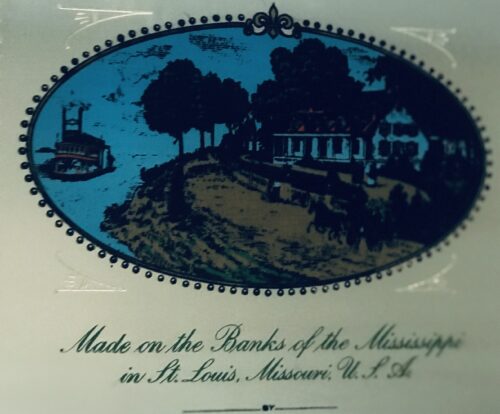
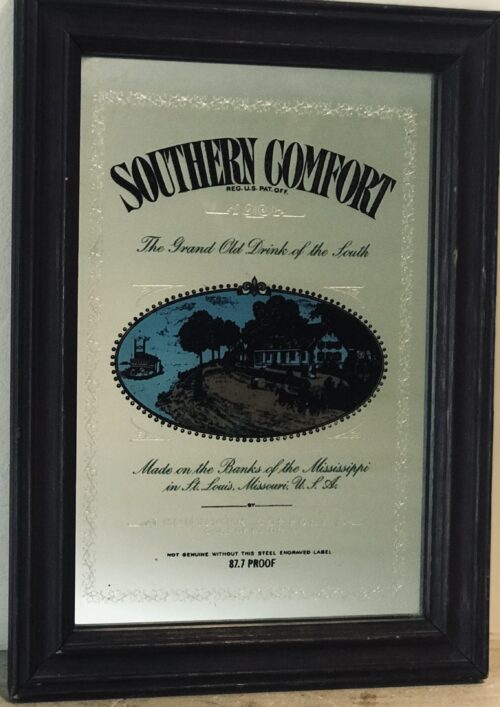 35cm x 25cm Southern Comfort (often abbreviated SoCo) is an American fruit-flavored liqueur with fruit and spice accents.The brand was originally created by bartender Martin Wilkes Heron in New Orleans in 1874, and originally used whiskey as the base spirit. Since March 1, 2016, the brand has been owned by the Sazerac Company, which purchased it from Brown–Forman.
35cm x 25cm Southern Comfort (often abbreviated SoCo) is an American fruit-flavored liqueur with fruit and spice accents.The brand was originally created by bartender Martin Wilkes Heron in New Orleans in 1874, and originally used whiskey as the base spirit. Since March 1, 2016, the brand has been owned by the Sazerac Company, which purchased it from Brown–Forman.History
Southern Comfort was first produced by bartender Martin Wilkes Heron (1850–1920), the son of a boat-builder, in 1874 at McCauley's Tavern in the Lower Garden District, two miles north of the French Quarter of New Orleans, Louisiana.According to the New Orleans Convention & Visitors Bureau, McCauley's Tavern was "just off Bourbon Street", and the original form of the drink was called Cuffs and Buttons. Heron moved to Memphis, Tennessee in 1889, patented his creation, and began selling it in sealed bottles with the slogan "None Genuine But Mine" and "Two per customer. No Gentleman would ask for more." Southern Comfort won the gold medal at the 1904 World's Fair in St. Louis, Missouri. In an episode of The Thirsty Traveler entitled "A River of Whiskey", spirits historian Chris Morris describes the original recipe of Southern Comfort. Heron began with good-quality bourbon and would add: A pre-2010 Southern Comfort bottle with its label showing an illustration of Louisiana's Woodland Plantation. The label was redesigned in 2010.
A pre-2010 Southern Comfort bottle with its label showing an illustration of Louisiana's Woodland Plantation. The label was redesigned in 2010.An inch of vanilla bean, about a quarter of a lemon, half of a cinnamon stick, four cloves, a few cherries, and an orange bit or two. He would let this soak for days. And right when he was ready to finish, he would add his sweetener: he liked to use honey.
The original brand closed during Prohibition and was reopened afterward by Francis Fowler. Between the 1930s and 2010, the image on the label of Southern Comfort was A Home on the Mississippi, a rendering by Alfred Waud depicting Woodland Plantation, an antebellum mansion in West Pointe à la Hache, Louisiana, which is listed on the National Register of Historic Places, and now provides bed-and-breakfast accommodation. In 2010 the plantation artwork was dropped from the label. Brown–Forman purchased the brand in 1979. In 2011, the brand began releasing flavored variations like cherry, lime, gingerbread, and Tabasco. In January 2016 Brown–Forman sold it to Sazerac Company, along with Tuaca, as part of a $543.5 million deal. Sazerac announced that Southern Comfort's formula would be changed in 2017 to restore whiskey as the base spirit, as the original formula used. Sometime before Brown–Forman purchased the brand, it had been reformulated to use neutral spirit, with only a negligible amount of whiskey as a flavorant. Janis Joplin was known to drink Southern Comfort to excess.Varieties
In the United States, Southern Comfort is available as 42 US proof (21% ABV), 70 US proof (35% ABV), 80 US proof (40% ABV), and 100 US proof (50% ABV). Varieties including additional flavorings, such as lime and caramel, were introduced by Brown–Forman in the latter years of their ownership. These were discontinued by Sazerac.Eggnog products
Also seasonally available through various retailers is Southern Comfort-branded eggnog. These currently include two variations of eggnog flavors, Traditional and Vanilla Spice. The Traditional flavor is usually available in one quart and half gallon sizes. These eggnog products contain no alcohol. Previously, there were also ground coffees available with both of these eggnog flavorings, but the coffee products have since been discontinued.In cocktails
Southern Comfort is used in the creation of numerous cocktails, including the Alabama Slammer. One of the earliest Southern Comfort-based cocktails to be marketed was the Scarlett O'Hara, named after the character and concocted in tribute to the release of the film adaptation of Gone with the Wind in 1939. The mixture includes Southern Comfort, cranberry juice, and fresh lime.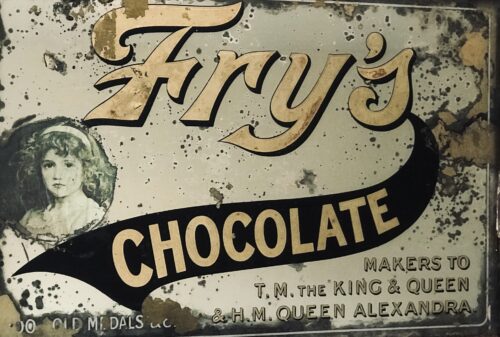
 Fantastic Frys Chocolate Advertising Mirror circa early 1900s. 40cm x 55cm Dublin S. Fry & Sons, Ltd. better known as Fry's, was a British chocolate company owned by Joseph Storrs Fry and his family. Beginning in Bristol in the 18th century, the business went through several changes of name and ownership, becoming J. S. Fry & Sons in 1822. In 1847, Fry's produced the first solid chocolate bar.[1][2] The company also created the first filled chocolate sweet, Cream Sticks, in 1853.[1] Fry is most famous for Fry's Chocolate Cream, the first mass-produced chocolate bar which was launched in 1866, and Fry's Turkish Delight, launched in 1914.[1] Fry, alongside Cadbury and Rowntree's, were the big three British confectionery manufacturers throughout much of the nineteenth and twentieth centuries.[3] The company became a division of Cadbury in the early twentieth century. The division's Somerdale Factory near Bristol was closed after the 2010 takeover of Cadbury's by Kraft Foods.
Fantastic Frys Chocolate Advertising Mirror circa early 1900s. 40cm x 55cm Dublin S. Fry & Sons, Ltd. better known as Fry's, was a British chocolate company owned by Joseph Storrs Fry and his family. Beginning in Bristol in the 18th century, the business went through several changes of name and ownership, becoming J. S. Fry & Sons in 1822. In 1847, Fry's produced the first solid chocolate bar.[1][2] The company also created the first filled chocolate sweet, Cream Sticks, in 1853.[1] Fry is most famous for Fry's Chocolate Cream, the first mass-produced chocolate bar which was launched in 1866, and Fry's Turkish Delight, launched in 1914.[1] Fry, alongside Cadbury and Rowntree's, were the big three British confectionery manufacturers throughout much of the nineteenth and twentieth centuries.[3] The company became a division of Cadbury in the early twentieth century. The division's Somerdale Factory near Bristol was closed after the 2010 takeover of Cadbury's by Kraft Foods.History[edit]
Joseph Fry, a Quaker, was born in 1728. He started making chocolate around 1759. In 1761 Joseph Fry and John Vaughan purchased a small shop from an apothecary, Walter Churchman, and with it the patent for a chocolate refining process.The company was then named Fry, Vaughan & Co.. In 1777 their chocolate works moved from Newgate Street to Union Street, Bristol. Joseph Fry died in 1787 and the company was renamed Anna Fry & Son. In 1795 Joseph Storrs Fryassumed control of the company. He patented a method of grinding cocoa beans using a Watt steam engine. As a result, factory techniques were introduced into the cocoa business. In 1803 Anna Fry died and Joseph Storrs Fry partnered with a Dr. Hunt. The business was renamed Fry & Hunt. In 1822 Hunt retired and Joseph Storrs Fry took on his sons Joseph, Francis and Richard as partners: the firm was renamed J. S. Fry & Sons. The company became the largest commercial producer of chocolate in the UK. In 1835 Joseph Storrs Fry died and his sons took full control. Tom Browne‘s advertisement postcard for Fry's chocolate, 1912In 1847, the Fry's chocolate factory, located in Union Street, Bristol, moulded a chocolate bar suitable for large-scale production.The firm began producing the Fry's Chocolate Cream bar in 1866.Over 220 products were introduced in the following decades, including production of the first chocolate Easter egg in UK in 1873 and the Fry's Turkish Delight (or Fry's Turkish bar) in 1914. In 1896 the firm became a registered private company. It was run by the Fry family, with Joseph Storrs Fry II, grandson of the first Joseph Storrs Fry, as the chairman. In 1881, an employee of Fry's H. J. Packer established his own chocolate business in Bristol. At its eventual home in Greenbank, Bristol, Packer's Chocolate continued to provide local competition for Fry's until 2006, under various owners and brands, from Bonds through to Famous Names and Elizabeth Shaw. Near the start of World War I the company was one of the largest employers in Bristol. Joseph Storrs Fry II died in 1913. By 1919 the company merged with Cadbury's chocolate and the joint company named British Cocoa and Chocolate Company. Under Egbert Cadbury the Fry's division began the move to Somerdale, Keynsham in 1923. After 1981 the name Fry's was no longer in use at Somerdale, but the factory was still a major producer of Cadbury's products. On 3 October 2007, Cadbury announced plans to close the Somerdale plant, the historic home of the Fry's Factory, by 2010 with the loss of some 500 jobs. In an effort to maintain competitiveness in a global marketplace, production was to be moved to a new factory in Poland. Another motivational factor was the high value of the land. Labour MP for Wansdyke, Dan Norris, said, "News of the factory's closure is a hard and heavy blow, not just to the workforce, but to the Keynsham community as a whole". In February 2010, following the takeover of Cadbury plc by Kraft Foods, the closure was controversially confirmed to take place in 2011; Kraft had specifically agreed during the takeover battle to keep the site open. There was widespread outrage in the press and later a House of Commons Select Committee investigation into the affair.Advertisement with the distinctive "five boys" design expressing "Desperation, Pacification, Expectation, Acclamation and Realization "It's Fry's". The reference to Queen Alexandra indicates a date before her death in 1925. Displayed in the Kirkcaldy Museum and Art Gallery
Tom Browne‘s advertisement postcard for Fry's chocolate, 1912In 1847, the Fry's chocolate factory, located in Union Street, Bristol, moulded a chocolate bar suitable for large-scale production.The firm began producing the Fry's Chocolate Cream bar in 1866.Over 220 products were introduced in the following decades, including production of the first chocolate Easter egg in UK in 1873 and the Fry's Turkish Delight (or Fry's Turkish bar) in 1914. In 1896 the firm became a registered private company. It was run by the Fry family, with Joseph Storrs Fry II, grandson of the first Joseph Storrs Fry, as the chairman. In 1881, an employee of Fry's H. J. Packer established his own chocolate business in Bristol. At its eventual home in Greenbank, Bristol, Packer's Chocolate continued to provide local competition for Fry's until 2006, under various owners and brands, from Bonds through to Famous Names and Elizabeth Shaw. Near the start of World War I the company was one of the largest employers in Bristol. Joseph Storrs Fry II died in 1913. By 1919 the company merged with Cadbury's chocolate and the joint company named British Cocoa and Chocolate Company. Under Egbert Cadbury the Fry's division began the move to Somerdale, Keynsham in 1923. After 1981 the name Fry's was no longer in use at Somerdale, but the factory was still a major producer of Cadbury's products. On 3 October 2007, Cadbury announced plans to close the Somerdale plant, the historic home of the Fry's Factory, by 2010 with the loss of some 500 jobs. In an effort to maintain competitiveness in a global marketplace, production was to be moved to a new factory in Poland. Another motivational factor was the high value of the land. Labour MP for Wansdyke, Dan Norris, said, "News of the factory's closure is a hard and heavy blow, not just to the workforce, but to the Keynsham community as a whole". In February 2010, following the takeover of Cadbury plc by Kraft Foods, the closure was controversially confirmed to take place in 2011; Kraft had specifically agreed during the takeover battle to keep the site open. There was widespread outrage in the press and later a House of Commons Select Committee investigation into the affair.Advertisement with the distinctive "five boys" design expressing "Desperation, Pacification, Expectation, Acclamation and Realization "It's Fry's". The reference to Queen Alexandra indicates a date before her death in 1925. Displayed in the Kirkcaldy Museum and Art GalleryArchives
Records relating to both the business and the family are held at Bristol Archives (Ref. 38538). Some records concerning the role of J. S. Fry & Sons within Cadbury are held with the Mondelez International repository at Cadbury's UK headquarters in Bournville.Popular culture
On the BBC television program Being Human, an old Fry's Cocoa billboard hangs prominently on the side of the B&B where the main characters reside in Series 3–5. The billboard is a nod to the show's original Bristol location. In April 2020 an original enamel advertising sign with the distinctive "five boys" trademark design was featured on BBC's Antiques Roadshow and was valued at £1,000-£1,500. The boy featured in the design, Lindsay Poulton, had been photographed in 1886 by his father who, for the first image, soaked a cloth in ammonia and wrapped it round the boy's neck to make him cry. Poulton, in his eighties, related this story to Fry's employees when he was given a tour of the Bristol factory.-
Somerdale Factory soon after opening
See also[edit]

 71cm x 97cm Newbridge Co Kildare Phenomenal original oil on canvas of a motionless Lester Piggott cantering to an easy victory on board a handsome bay colt.The famous colours of the Aga Khan and Lady Clague can be seen battling for the minor honours.
71cm x 97cm Newbridge Co Kildare Phenomenal original oil on canvas of a motionless Lester Piggott cantering to an easy victory on board a handsome bay colt.The famous colours of the Aga Khan and Lady Clague can be seen battling for the minor honours."Lester Piggott, a dapper yet gaunt man, ghosts across the cold marble floor of a hotel in Mayfair with a vaguely haunted expression. The prospect of another interview, after a lifetime of such encounters, does not fill the great old jockey with glee. He has heard every question before and, as an infamously reluctant communicator, he has dodged most since his first winner in 1948. A Piggott interview is meant to be a challenge like no other.
Having spent the past few days consumed by grainy yet riveting footage of Piggott riding magnificent horses like Nijinsky and Sir Ivor, or watching him show a brutal need to win while driving on Roberto and The Minstrel to victory in the Derby in the 1970s, I launch into an earnest waffle of a greeting.
“Hello,” the 79-year-old Piggott says in his whispery mumble, offering a fleeting handshake.
Piggott’s life – stretching from 11 champion jockey titles and 30 Classic victories to a tangled personal life and being jailed for tax evasion – has always been compelling and prickly. Who else has won the Derby nine times, been stripped of his OBE and waged war against his own body so that he could scale 30 pounds less than his natural weight? The vivid backdrop lingers and a splash of colour peeks out in the form of Piggott’s pink shirt beneath a sober grey suit.
Forty years ago, when known as the Long Fellow, Piggott’s fame saw him ranked alongside Muhammad Ali, Pelé and George Best. Ali boasted loudly and justifiably that he was The Greatest; but the Long Fellow preferred icy silence or his trademark mumble.






